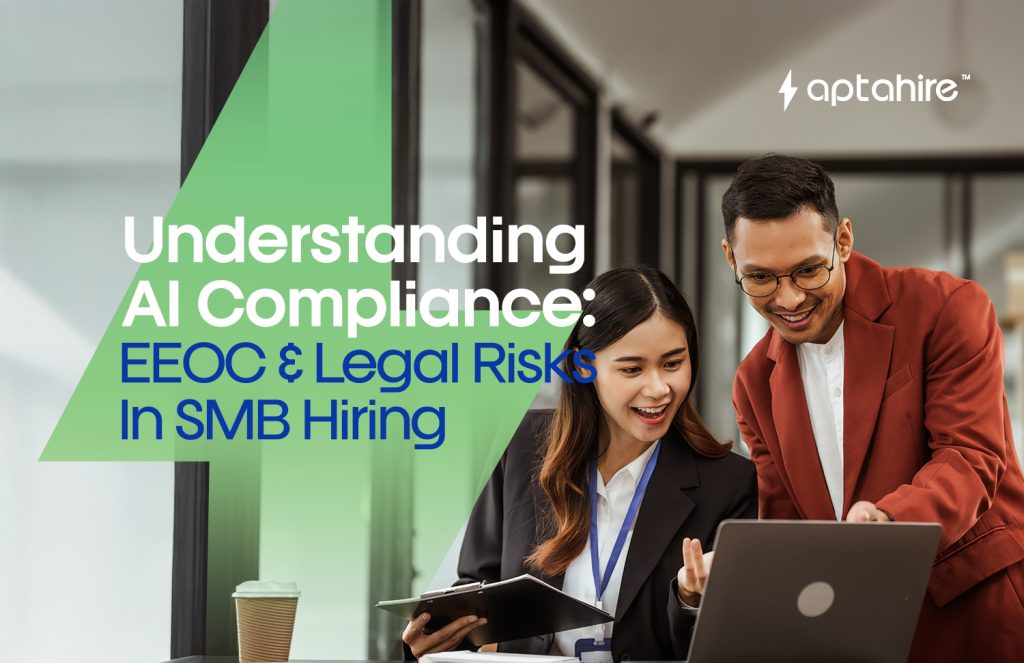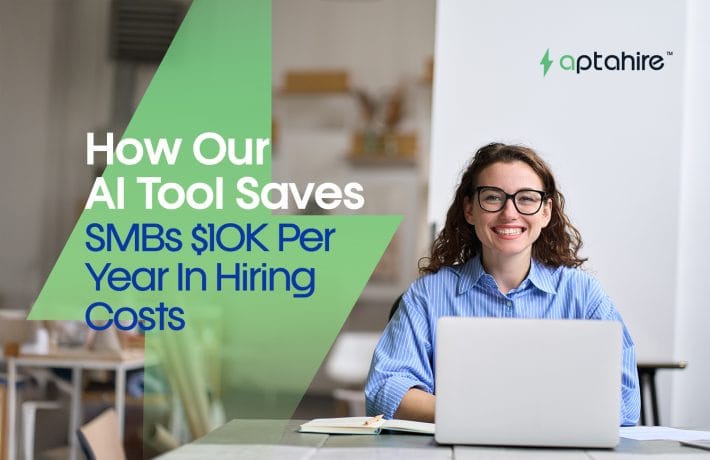Understanding AI Compliance: EEOC & Legal Risks in SMB Hiring

Hiring today isn’t what it used to be. With the rise of Artificial Intelligence (AI), small and medium-sized businesses (SMBs) now have access to cutting-edge hiring tools that were once reserved for big enterprises. AI promises faster, smarter, and more efficient recruitment. But alongside the speed and savings comes a critical responsibility: compliance.
SMBs are especially vulnerable. Why? Because many don’t have in-house legal teams or seasoned HR professionals to vet their tools and processes. That’s where understanding EEOC regulations and potential legal risks becomes essential.
In this blog, we’ll break down:
- What AI in hiring means
- The role of EEOC compliance
- Legal risks for SMBs
- Common pitfalls
- How to ensure ethical, bias-free, and compliant AI hiring
Let’s dive in.
What Is AI in Hiring, Really?
AI hiring tools automate parts of the recruitment process using machine learning, natural language processing, and data analytics. They help SMBs with:
- Writing inclusive job descriptions
- Screening resumes
- Ranking candidates
- Conducting video interviews
- Predicting job performance
These tools save time, reduce human bias, and can lower cost-per-hire by up to 30%, especially for businesses without an HR department.
But here’s the catch: automated decisions can inherit human bias or create new forms of discrimination if not implemented responsibly.
What Is the EEOC and Why Should SMBs Care?
The Equal Employment Opportunity Commission (EEOC) is the U.S. agency responsible for enforcing federal anti-discrimination laws in employment.
They prohibit discrimination based on:
- Race
- Color
- Religion
- Sex (including pregnancy, sexual orientation, and gender identity)
- National origin
- Age (40 or older)
- Disability
- Genetic information
This applies to any stage of employment, including hiring.
In 2023, the EEOC made it very clear: employers are responsible for the outcomes of AI tools they use, even if those tools are developed by third-party vendors.
For SMBs, this means:
- You can’t blame the software for biased decisions
- You must understand how the AI tool works
- You’re legally accountable if it screens out candidates unfairly
The Legal Risks of AI Hiring for SMBs
Many SMBs rush into AI hiring tools for speed and efficiency. But without proper checks, this can lead to serious consequences:
1. Discrimination Lawsuits
If your AI system disproportionately filters out candidates from protected classes (e.g., women, people with disabilities), you could face legal action under Title VII or the ADA.
Example: In 2022, an AI tool used by an e-commerce firm was found to exclude candidates with gaps in employment, indirectly impacting women returning from maternity leave. This led to an EEOC investigation.
2. Data Privacy Violations
Some AI tools analyze facial expressions, tone, or other biometric data. Collecting or storing such information without consent can breach state laws like Illinois’ BIPA (Biometric Information Privacy Act).
3. Lack of Transparency
Many AI vendors don’t explain how their tools make decisions. If you can’t explain why a candidate was rejected, that lack of transparency can be a legal red flag.
4. Disparate Impact
Even if your hiring process seems neutral, if it results in a disproportionate negative impact on a protected group, it could still be illegal.
5. Recordkeeping Failures
The EEOC requires employers to keep detailed hiring records. If your AI tool doesn’t log decisions or retain candidate data properly, you could be fined.
How to Ensure EEOC Compliance in AI Hiring
1. Ask the Right Questions to Your AI Vendor
- How is your algorithm trained?
- What datasets were used?
- Is the model audited for bias?
- Do you provide audit logs?
- Is your tool compliant with EEOC and local laws?
2. Perform Regular Bias Audits
Ask for third-party fairness audits or conduct internal evaluations. Look for:
- Gender or racial disparities in hiring outcomes
- Patterns in rejections
- Interview scoring variances
3. Use Explainable AI (XAI)
Choose tools that can explain their decision-making process. Transparency builds trust and offers legal protection.
4. Offer Human Review Options
Never let AI be the sole decision-maker. A human review step can catch errors and ensure fairness.
5. Train Your Team
Ensure hiring managers and recruiters understand AI capabilities, limitations, and legal obligations.
6. Customize for Your Use Case
Off-the-shelf tools might not match your needs. Customization helps avoid misfit decisions and biased assessments.
7. Get Informed Consent
If your tool collects any biometric or sensitive data (e.g., voice recordings, facial analysis), always disclose and get consent.
SMB-Friendly AI Hiring Tools with Compliance Focus
Some platforms prioritize compliance and transparency:
- Aptahire – Emphasizes ethical AI and offers candidate-friendly transparency features
- HireVue – Offers bias audits and compliance tools
- Pymetrics – Uses neuroscience-based games with EEOC-aligned frameworks
- SeekOut – Provides diversity sourcing and analytics
Real-World SMB Scenario: How Compliance Saved a Startup
A 12-person tech startup based in Chicago adopted an AI hiring tool to scale quickly. They unknowingly used default settings that scored non-native English speakers lower in video interviews.
After one candidate filed a complaint, they faced an EEOC audit. Thankfully, they had:
- Detailed audit logs
- Human-reviewed interview stages
- Vendor-supplied bias reports
They cooperated transparently and avoided legal trouble. Post-incident, they switched to a tool with clearer explainability and introduced DEI (Diversity, Equity, Inclusion) training.
Common Compliance Pitfalls to Avoid
- Using AI tools with unclear sourcing or datasets
- Not reviewing rejected candidate data
- Relying solely on automation
- Ignoring local and state data privacy laws
- Lack of consent for facial or voice analysis
- Failing to log hiring decisions or scoring metrics
What the EEOC Expects from Employers Using AI
According to their 2023 technical guidance, the EEOC expects:
- Proactive bias testing
- Clear candidate communication
- Access to human review on decisions
- Equal opportunity for candidates with disabilities
- Compliance documentation and audit trails
They’re also partnering with the DOJ and FTC to scrutinize algorithmic discrimination more closely.
Final Thoughts: Compliance Isn’t Optional. It’s Smart Business.
AI is a powerful hiring ally, but only when used responsibly. For SMBs, it’s easy to fall into the trap of convenience over compliance. But the legal, ethical, and reputational risks can outweigh the short-term gains.
By aligning your AI hiring strategy with EEOC guidelines, you not only avoid lawsuits and fines, but you also:
- Build a more inclusive workforce
- Create a better candidate experience
- Gain long-term trust from employees and customers
So don’t just ask, “How fast can we hire with AI?” Also ask, “How fairly and compliantly can we hire with it?”
Because the future of hiring isn’t just automated. It’s also accountable.
FAQs
1. What is the meaning of AI compliance?
AI compliance refers to the adherence of artificial intelligence systems to legal, ethical, and regulatory standards. It ensures that AI technologies operate transparently, fairly, securely, and without discrimination. This involves complying with data protection laws (like GDPR or HIPAA), avoiding algorithmic bias, maintaining explainability, and being accountable for decisions made by AI models.
2. How to be AI compliant?
To ensure AI compliance, organizations should:
- Conduct risk assessments to understand potential harms or biases in AI systems.
- Implement data governance policies to secure and manage data ethically.
- Ensure transparency by documenting how algorithms function and make decisions.
- Validate and audit models regularly for fairness, accuracy, and bias.
- Comply with regulations like GDPR, EEOC, AI Act (EU), or sector-specific laws.
- Obtain consent when collecting and using personal data.
- Provide human oversight in AI-driven decisions, especially in critical areas like hiring, lending, or healthcare.
3. What are the compliance concerns of AI?
Major compliance concerns in AI include:
- Data Privacy Violations: Mishandling or misusing sensitive user data.
- Algorithmic Bias: Discriminatory outcomes based on race, gender, age, etc.
- Lack of Transparency: “Black box” models that don’t explain how decisions are made.
- Security Risks: AI systems can be vulnerable to cyberattacks or adversarial inputs.
- Lack of Accountability: Difficulty in assigning responsibility for AI-driven decisions.
- Regulatory Mismatch: AI evolving faster than current laws, leading to grey areas in compliance.
4. What is the policy compliance of AI?
Policy compliance of AI means ensuring that AI systems operate within the guidelines defined by internal organizational policies and external regulatory frameworks. These policies typically address:
- Ethical AI usage
- Data security and user privacy
- Fairness and non-discrimination
- Use-case limitations (e.g., banning AI in certain HR or surveillance applications)
- Governance structures for AI lifecycle management
- Reporting and auditability standards
It ensures that the AI is aligned with both legal obligations and company values.
5. Can AI replace compliance?
No, AI cannot fully replace compliance. While AI can assist in compliance tasks, like automating audits, flagging anomalies, ensuring policy adherence, or analyzing large volumes of data for violations, it cannot own accountability or interpret complex regulatory nuances. Human oversight is essential to interpret laws, make ethical decisions, and ensure context-sensitive compliance.
AI is a tool to enhance compliance, not a substitute for it.
6. What is the full form of AI in audit?
In an audit context, the full form of AI is still Artificial Intelligence.
However, in this domain, AI typically refers to AI-powered auditing tools that help:
- Automate repetitive tasks like invoice or document checks
- Detect fraud or anomalies in financial records
- Conduct real-time transaction monitoring
- Ensure internal policies and regulatory compliance are followed
So while “AI” = Artificial Intelligence, in audit, it’s specifically applied to enhance speed, accuracy, and coverage of audit processes.



